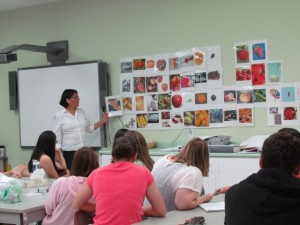Hello, folks! Reporting from Listuguj here, where there has been a lot of work done towards setting up CAN-8 for real live users. We’ve been focussing on
- making connections with (potential) users of the program
- establishing a work-flow that works for people involved in the project (more on this below), and
- recording and uploading content
We’ll start off talking about that first point, making connections. We’re hoping to create a CAN-8 that is geared towards the people using it. Part of this is listening the input of anybody who has an opinion to give. Vicky Metallic has been getting the word out to people outside the Education Complex that the CAN-8 project is happening, and that another tool for Mi’gmaq-learning will be added to the considerable resources that the community already has at its fingertips. We’ve all been talking to people, and in doing so, we’ve also been taking the advice of the people who have seen the program. We’ll use their input to select scenarios for dialogue-making, so that our content is relevant to the lives of the people who are using it.
Next up, the question of “how do the dialogues get made, anyway”? The fine details of this process are still being hammered out, but we have a general outline that works well for us! We write scripts in part-English, part-Mi’gmaq, then Joe Wilmot and his trusty team work with us to tweak the scripts so they flow like real Mi’gmaq. Once the scripts are speaker-worthy, Joe et al record them. The resulting sound files and Mi’gmaq scripts go into CAN-8, so far by my hands, but hopefully this will become a Montreal job soon. And later, we will write up helpful meta-linguistic notes which also go into CAN-8 for the users’ enjoyment.
There are two kinds of dialogue: implicit teaching ones, and daily life ones. These two categories do overlap quite a bit sometimes, but they aren’t one and the same!
For the implicit teaching dialogues:
- Conor and I work on establishing corners of the grammar that might be tricky for learners to pick up directly from speakers–there is a lot that people can learn from the speakers around them, but we’d like to give people some scaffolding to base that knowledge on, and make speaker-knowledge more accessible to more people.
- Once these corners are picked, we then use a theme to construct a little scene. One starts with a boy telling a girl, “I love you!” and she replies, “You love me, but I don’t love you.”–they talk to each other, and explain the predicament to others, and (spoilers!) he eventually wins her over. The aim of this dialogue is to demonstrate TA morphology in a (hopefully) fun and funny way!
- Lastly, we give an overt, meta-linguistic description of the phenomenon in question. We also encourage the CAN-8 learner to go back to the dialogue they just heard with these meta-linguistic notes in mind, and will provide a CAN-8 space to experiment with the forms on their own.
The daily life dialogues are a little different. We don’t have many of them, but we’ll collect more as the summer goes on!
- Two (or maybe three) speakers record a mostly-improvised chat about topics that are likely to come up. One chat that we have already uploaded features a phone call between two speakers, where one invites the other to go across the river for some shopping.
- We then go over the recording with the speakers in question, and transcribe the exchange. This transcription gives CAN-8 users a chance to familiarize themselves with the orthography we’re using, as well as something to hang on to (as this speech tends to be a little faster than the scripted dialogue speech).
- The dialogues are then uploaded! The advantage of these improvised chats is that they are less artificial than the scripts, and will give the CAN-8 user a window into natural speech that they are likely to hear (and eventually produce) with the speakers in their lives.
We’ve also uploaded the rhythmic profiles that we’ve talked about in a previous post, and Roger Metallic is working on Mi’gmaq-izing some of the Akwesasne verb conjugations and integrating them into the Listuguj CAN-8, too. There’s a lot going on, here!
And, as always, please chat with us in comments!
- What do you think of our plan and strategy? What are the things that we’re missing?
- Do you have any suggestions for material to cover?
- Do you have suggestions for new methods to use to show linguistic patterns?
- What have been your favourite bits about self-directed language-learning programs in the past? Should our CAN-8 program have them, too?

